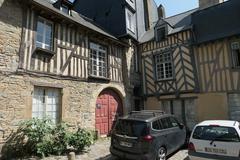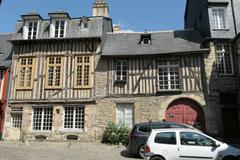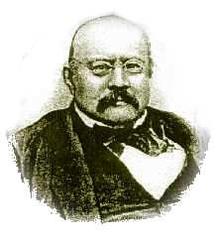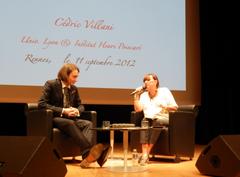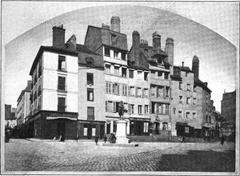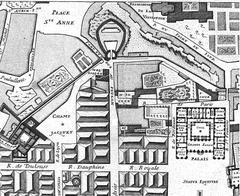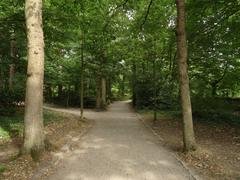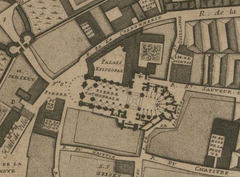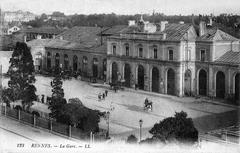
Maison Saint-Pierre Visiting Hours, Tickets, and the Ultimate Guide to Rennes’ Historic Cathedral
Date: 14/06/2025
Introduction
Set in the heart of Rennes’ vibrant historic center, Maison Saint-Pierre—often identified with the Cathédrale Saint-Pierre de Rennes—stands as a cornerstone of Brittany’s religious, architectural, and cultural legacy. With roots reaching back to the 6th century, this complex has evolved through Romanesque, Gothic, and Neoclassical styles, serving as both the seat of the Archbishop of Rennes and a beacon for art, history, and faith. This guide provides everything you need to plan your visit, including current visiting hours, ticketing, accessibility, nearby attractions, and tips for maximizing your experience in Rennes (Monumentum, Diocese of Rennes, Guide Tourisme France).
Historical Overview
Early Origins and Medieval Foundations
The site’s religious significance dates to Brittany’s early Christianization in the 6th century, when the first church was established. By the 12th century, a Romanesque edifice had replaced the original structure, marking Rennes’ emergence as a spiritual and civic hub (France Voyage).
Maison Saint-Pierre’s Role
Maison Saint-Pierre historically housed the cathedral’s choirboys, who played a central role in religious ceremonies. Built in the 17th century at 10–12 rue de la Psalette, the structure is now a listed historical monument, underscoring its importance within the cathedral complex and the broader fabric of Breton ecclesiastical life (Monumentum).
Architectural Evolution and Restoration
Over centuries, the cathedral and its annexes have undergone significant transformations, blending Romanesque, Gothic, Baroque, and Neoclassical elements. Notably, the western façade, completed in the 18th century, showcases Neoclassical grandeur with monumental columns and twin granite towers. Restoration efforts in the 19th and 21st centuries have preserved both the structural and artistic integrity of the ensemble (Monumentum, France Voyage, Guide Tourisme France).
Religious and Social Importance
Maison Saint-Pierre served as a formative residence for generations of choirboys, facilitating their integration into the cathedral’s liturgical life. The building’s communal spaces fostered study, music rehearsal, and religious education, embedding it deeply into the region’s spiritual culture (Monumentum).
Heritage Status
Maison Saint-Pierre is protected as a historical monument (Base Mérimée PA00090721), reflecting its lasting architectural and cultural value, and its role in upholding the religious and civic identity of Rennes (France Voyage).
Visitor Information
Visiting Hours
- Maison Saint-Pierre: Generally closed to the public except during special events, notably European Heritage Days (Journées Européennes du Patrimoine) in September.
- Cathédrale Saint-Pierre de Rennes: Open daily from 9:30 AM to 11:55 AM and 3:00 PM to 6:00 PM. Hours may vary for holidays and special liturgical events (Guide Tourisme France).
Tickets and Tours
- Admission: Free for both the cathedral and Maison Saint-Pierre (when open during special events).
- Guided Tours: Available for the cathedral and historic precinct in multiple languages. Tours can be booked via the Rennes Tourist Office.
- Audio Guides: Offered for self-guided visits.
Accessibility
- Maison Saint-Pierre: Due to its historic nature, full accessibility is limited; check with event organizers for special arrangements during open days.
- Cathedral: Main entrance is wheelchair accessible; accessible restrooms available.
Location and Getting There
- Address: 10–12 rue de la Psalette, 35700 Rennes, France (Monumentum)
- Public Transport: Close to Sainte-Anne metro station; 15-minute walk from the Rennes TGV station. Buses also serve the area (Tourisme Rennes).
Travel Tips
- Best Time to Visit: During European Heritage Days for rare access to Maison Saint-Pierre, or local festivals for lively cultural experiences.
- Nearby Amenities: Numerous cafés, restaurants, and shops in the cathedral district.
Architectural and Artistic Highlights
Cathedral Exterior
- Western Façade: Neoclassical design with monumental columns and twin granite towers.
- Towers: Rising to 48 meters, capped with domes—distinctive in French cathedral architecture.
Interior Features
- Nave and Choir: Gothic vaulting, Baroque high altar, and a luminous apse with 19th-century stained glass.
- Chapels: Side chapels dedicated to local saints and patrons, showcasing 18th-century art and relics.
- Stained Glass: Medieval fragments and 19th-century windows illuminate biblical and local saintly narratives.
- Frescoes: Eight encaustic frescoes by Alphonse Le Hénaff depict the Procession of Breton Saints, reinforcing the region’s Christian heritage (Diocese of Rennes).
Suggested Visuals:
- Façade of Maison Saint-Pierre (alt: “17th-century stone façade of Maison Saint-Pierre in Rennes”)
- Cathedral nave and stained glass (alt: “Gothic nave and stained-glass windows inside Cathédrale Saint-Pierre de Rennes”)
Special Events and Liturgical Calendar
- Liturgical Celebrations: Hosts ordinations, diocesan jubilees, Chrism Mass, and major feast days.
- 2025 Jubilee: Designated “jubilee church” for the Holy Year, offering plenary indulgences for pilgrims (Diocese of Rennes).
- Cultural Events: Concerts, art exhibitions, and guided meditations on the cathedral’s frescoes.
Exploring Rennes: Nearby Attractions
- Parlement de Bretagne: 17th-century seat of the regional parliament, open for tours.
- Place du Champ-Jacquet: Timber-framed houses and lively cafés (France Today).
- Marché des Lices: Renowned Saturday market offering Breton specialties.
- Parc du Thabor: Expansive gardens with aviaries and rose gardens (Bonadvisor).
- Les Champs Libres: City’s cultural center with museums and library.
- Day Trips: Mont Saint-Michel and Saint-Malo are accessible for excursions (The Crazy Tourist).
Practical Visitor Tips
- Dress Code: Modest attire required; silence requested during services.
- Photography: Allowed without flash in most areas; restricted during liturgical functions.
- Rennes City Pass: Offers discounted access to attractions and transport (Voyage Tips).
- Accessibility: Contact Tourist Office for details and assistance.
- Language: French is primary; English spoken at most tourist sites.
Frequently Asked Questions (FAQ)
Q: Are tickets required for Maison Saint-Pierre or the cathedral?
A: No, both are free to visit. Guided tours may require advance booking.
Q: When is Maison Saint-Pierre open to the public?
A: Typically only during special events like European Heritage Days.
Q: Is the cathedral fully accessible?
A: The main entrance and restrooms are accessible; some historic areas may pose challenges.
Q: Can I take photographs?
A: Yes, except during religious services or in designated areas.
Q: Are guided tours available in English?
A: Yes, via the Tourist Office.
Q: What are nearby attractions?
A: Parlement de Bretagne, Place du Champ-Jacquet, Marché des Lices, Parc du Thabor, and more.
Conclusion
Maison Saint-Pierre and the Cathédrale Saint-Pierre de Rennes together offer a powerful journey through the spiritual and cultural heart of Brittany. With their blend of historic architecture, artistic treasures, and vibrant community life, these landmarks are essential for any visitor to Rennes. Plan your trip around special openings and events, explore the surrounding medieval district, and use official resources and digital tools to enrich your experience.
For up-to-date information on hours, guided tours, and events, consult the Rennes Tourist Office and the Diocese of Rennes.
Download the Audiala app for immersive audio guides, and follow us on social media for the latest on Rennes’ history and cultural events. Share your experiences using #MaisonSaintPierreRennes.
Sources and Further Reading
- Maison Saint-Pierre in Rennes: History, Visiting Hours, Tickets, and Visitor Guide, 2025
- Cathédrale Saint-Pierre de Rennes: Visiting Hours, Tickets, and Historical Guide to Rennes’ Iconic Cathedral, 2025
- Guide Tourisme France, 2025
- Tourisme Rennes, 2025
- France Voyage, 2025
- Audiala, 2025
- France Today
- Bonadvisor
- The Crazy Tourist
- Voyage Tips
